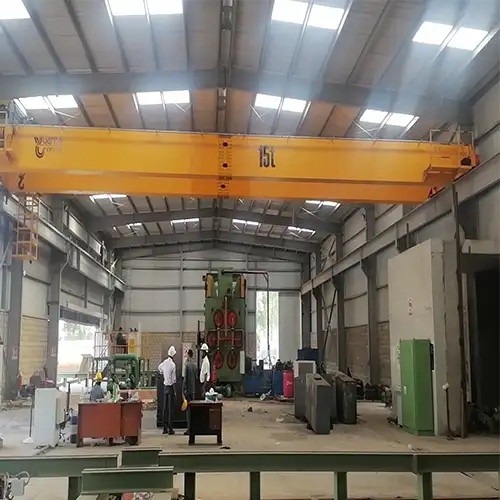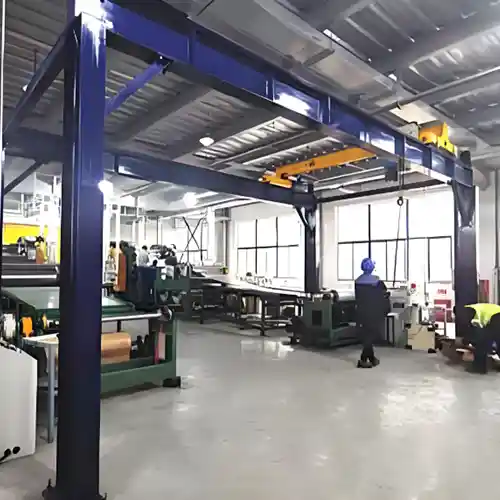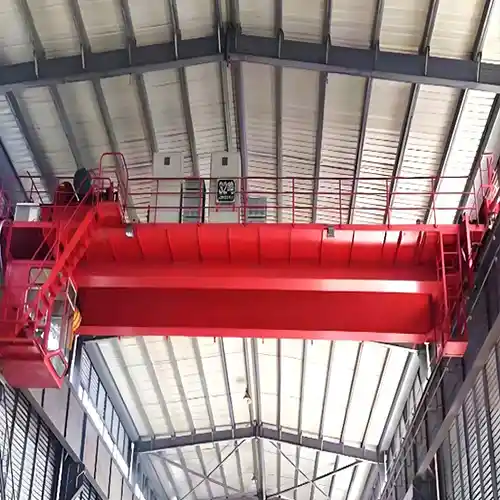Industrial Overhead Crane for Sale, Get Right 15 Ton Indoor Crane
Indoor overhead crane for sale. Check types, design options & application of 15 ton indoor overhead crane for safe, efficient industrial material handling.
Category: Featured
Your Trusted Overhead Crane Manufacturer & Supplier
Choosing the Right 15 Ton Indoor Overhead Crane – A Buyer's Guide
Industrial Overhead Crane for Sale
Introduction: Why a 15 Ton Industrial Overhead Crane Matters
In any modern workshop or factory, a 15 ton industrial crane isn't just a tool—it's a backbone for moving heavy loads safely and efficiently. Whether you call it an industrial overhead crane or an indoor overhead crane, the principle is the same: it allows you to lift, transport, and position large and heavy items that would be impossible—or unsafe—to move manually.
For indoor crane applications, the benefits go beyond lifting power. These cranes keep the floor clear, reduce the need for forklifts, and allow smooth material flow across the production area. They're used to handle everything from machinery and molds to steel plates, beams, and other heavy equipment. In short, a good indoor crane keeps work moving and operators safe.
Scenario example: Imagine a steel fabrication workshop with stacks of steel plates. Workers need to move these plates from storage to cutting and welding stations multiple times a day. A 15 ton bridge crane makes this task straightforward, precise, and much safer than manual handling or forklifts.
Why choosing the right 15 ton indoor crane matters:
- Ensures safety for operators and personnel around the crane.
- Optimizes workflow and efficiency, reducing bottlenecks in material handling.
- Provides the right lifting capacity and span for your specific industrial applications.
- Future-proofs your investment for heavier loads or expanded operations.
By understanding the importance of a 15 ton industrial overhead crane in indoor operations, buyers can make informed decisions that fit both the building structure and the workflow.
Types of 15 Ton Indoor Cranes and Their Applications
Understanding the different 15 ton indoor cranes is key to choosing the right system for your workshop or facility. Each type has specific strengths depending on lifting frequency, building structure, and the type of material handled.
Choosing the right 15 ton indoor crane depends on your workflow, building structure, and material handling needs. Each crane type offers different benefits for indoor industrial operations.
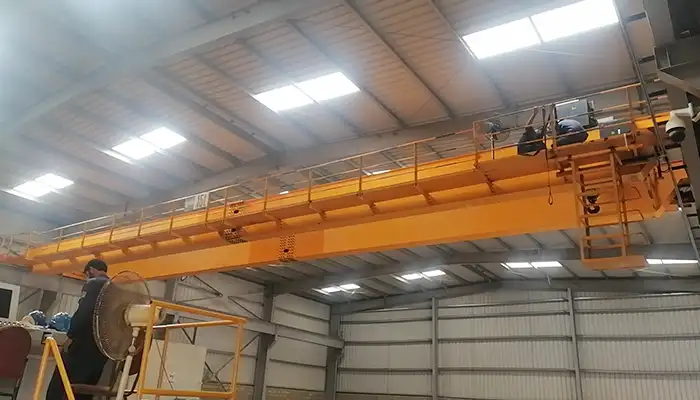
Top-Running Double-Girder 15 Ton Overhead Bridge Crane
A 15 ton overhead crane with a double-girder bridge design is built for heavy-duty, high-frequency lifting. The wire rope hoist crane sits on top of the dual girders, providing maximum hook height and stability.
Key Features:
- Equipped with VFD crane drives for smooth and precise motion
- Operable via radio remote control for safe and flexible operation
- Future-ready for additional hoists, automation, or service platforms
Applications:
Workshop crane moving molds and presses across multiple bays
- Sectors: Plastics, rubber, metal casting, automotive
- Facilities: Mold-making workshops, injection molding plants, foundries
Steel fabrication lines transporting plates, beams, or welded assemblies
- Sectors: Steel fabrication, metalworking, shipbuilding
- Facilities: Steel mills, metal fabrication shops, heavy engineering plants
Material handling in factories requiring clear floor space
- Sectors: Warehousing, logistics, industrial manufacturing
- Facilities: Multi-bay production halls, assembly plants, storage facilities
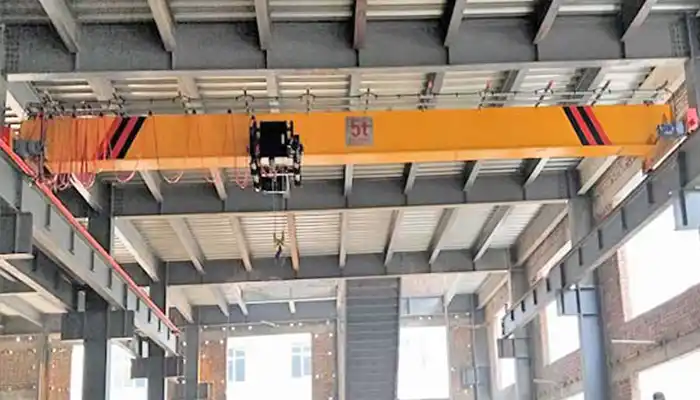
Top-Running Single-Girder Overhead Bridge Crane
The single-girder bridge crane is a cost-effective option for moderate-duty indoor lifting. The hoist runs beneath a single girder, reducing structural weight and simplifying installation.
Key Features:
- Wire rope hoist crane mounted under the girder
- Lighter, simpler design than double-girder cranes
- Handles full 15-ton loads with easier installation and lower upfront cost
Applications:
Maintenance workshops lifting machinery and spare parts
- Sectors: Industrial maintenance, manufacturing support, automotive service
- Facilities: Machinery repair workshops, factory maintenance bays
Assembly lines with occasional heavy lifts
- Sectors: Electronics assembly, machinery manufacturing, light engineering
- Facilities: Assembly halls, component manufacturing workshops
General material handling with fewer repetitive lifts per shift
- Sectors: Light manufacturing, industrial warehousing
- Facilities: Small to mid-sized factories, stockrooms, tool rooms
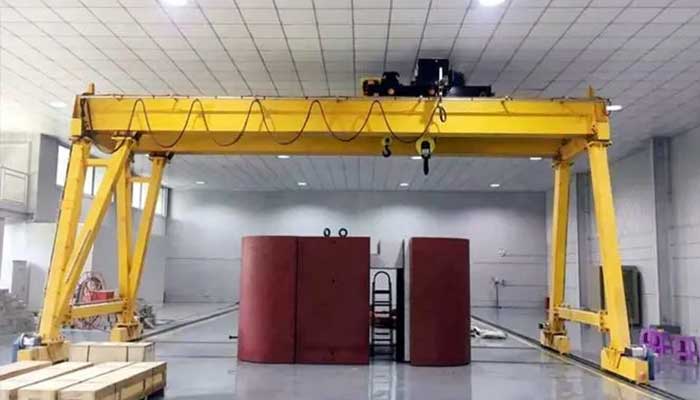
Full Gantry Crane on Recessed Floor Rails for Indoor Uses
A Indoor use full gantry crane, also known as an indoor gantry crane, is designed for areas where walls or roof cannot support crane loads. Its independent frame runs on floor rails recessed into concrete.
Key Features:
- Fully independent structure, eliminating stress on walls or ceilings
- Floor rails recessed in concrete for flush installation
- Adaptable layout for future modifications or extended spans
Applications:
Indoor bays handling steel plates, machinery, and molds
- Sectors: Steel fabrication, machinery manufacturing, heavy engineering
- Facilities: Fabrication workshops, machine shops, production bays
Temporary or modular setups in weak-walled facilities
- Sectors: Construction equipment assembly, modular manufacturing
- Facilities: Temporary industrial bays, portable workshops
Areas requiring a crane independent of the building structure
- Sectors: Heavy industrial workshops, warehouses
- Facilities: Workshops with weak walls, retrofit production halls
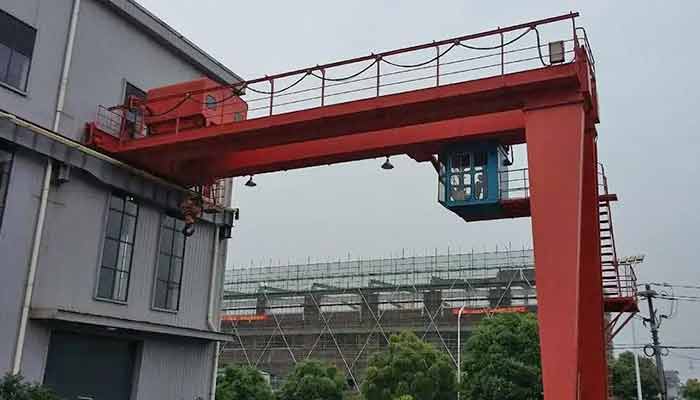
A semi-gantry crane combines a gantry and bridge crane, with one side on a floor rail and the other anchored to a wall bracket. This design is perfect for mixed structural conditions.
Key Features:
- One side supported on the floor, the other anchored to a wall bracket
- Safely lifts full 15-ton loads with proper engineering
- Offers a compromise between structural constraints and usable floor space
Applications:
Workshops with partial obstructions or machinery lines along one wall
- Sectors: Automotive manufacturing, tool making, light metalworking
- Facilities: Partial-obstruction bays, machine-lined workshops
Rooms with uneven structural support
- Sectors: Industrial maintenance, small to mid-sized production facilities
- Facilities: Maintenance bays, retrofit production halls
Facilities needing heavy lifting with limited space for full gantry installation
- Sectors: Warehousing, plastics, light machinery assembly
- Facilities: Compact indoor workshops, low-ceiling production areas
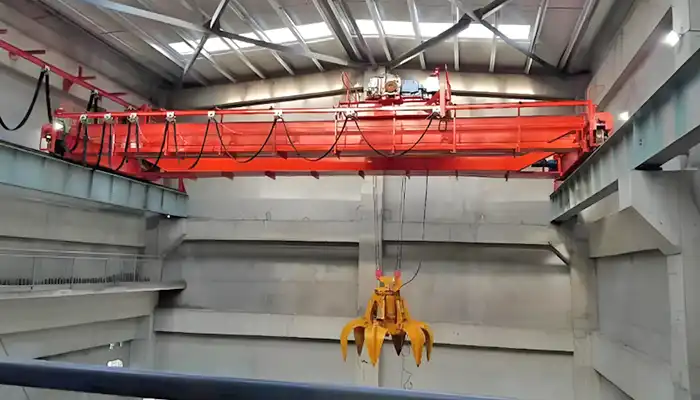
Grab Bucket Overhead Crane 15 Ton
A grab bucket overhead crane is specifically designed for handling bulk materials like sand, coal, ores, or scrap metal. The crane is equipped with a grab bucket that opens and closes to pick up loose loads efficiently.
Key Features:
- Specialized grab bucket attachment for bulk material handling
- Can operate with wire rope hoist crane mechanisms
- Smooth operation with VFD crane drives for controlled lifting and lowering
- Suitable for repetitive, high-capacity lifts
Applications:
Material handling in steel mills and foundries
- Sectors: Steel production, iron and non-ferrous metals
- Facilities: Raw material storage bays, scrap yards, melting workshops
Handling bulk powders or grains
- Sectors: Cement, chemical, or fertilizer industries
- Facilities: Storage silos, batching plants, indoor material handling lines
Loading and unloading trucks or hoppers indoors
- Sectors: Industrial logistics, heavy engineering
- Facilities: Factory loading bays, indoor storage areas
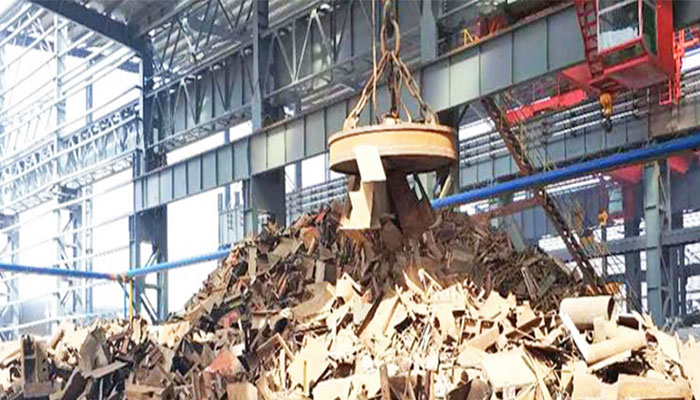
Magnetic Overhead Crane 15 Ton
A magnetic overhead crane uses a strong electromagnet to lift and transport ferrous materials such as steel plates, billets, or scrap. This makes it ideal for handling heavy metals without hooks or slings.
Key Features:
- Equipped with a powerful electromagnet for lifting steel and iron materials
- Integrated wire rope hoist crane and VFD drives for precise movement
- Can lift heavy metal sheets or scrap safely and efficiently
- Easy to control load positioning with radio remote options
Applications:
Steel fabrication shops handling plates and billets
- Sectors: Steel mills, metalworking, shipbuilding
- Facilities: Plate storage bays, cutting and welding areas
Scrap yards and recycling facilities
- Sectors: Metal recycling, ferrous scrap processing
- Facilities: Indoor scrap storage, sorting lines
Warehouses with heavy ferrous goods
- Sectors: Industrial logistics, manufacturing
- Facilities: Indoor storage halls, distribution centers
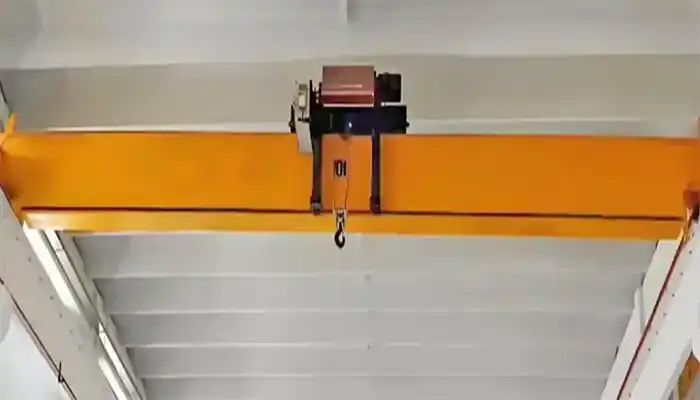
15 Ton Low Headroom Crane with European Style Electric Hoist Trolley
A low headroom crane or low built hoist and cranes is perfect for indoor facilities with limited vertical space. Combined with a European-style electric hoist trolley, it maximizes lifting height and efficiency.
Key Features:
- Low headroom design to fit under limited ceiling clearance
- Uses a European-style wire rope hoist trolley for compact, precise lifting
- VFD crane drives for smooth, energy-efficient operation
- Can safely lift full 15-ton loads in confined spaces
Applications:
Maintenance and assembly workshops with low ceilings
- Sectors: Automotive, machinery manufacturing, light metalworking
- Facilities: Repair bays, low-headroom production halls
Indoor steel plate or mold handling
- Sectors: Plastic molds, metal fabrication
- Facilities: Mold storage rooms, indoor cutting and assembly areas
Small-to-medium factories needing maximum hook height
- Sectors: Industrial manufacturing, warehouse operations
- Facilities: Compact indoor workshops, retrofit production lines
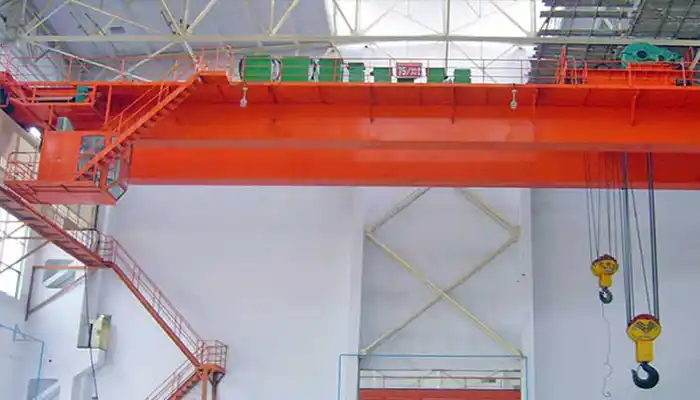
Explosion-Proof Indoor Overhead Crane – 15 Ton
An explosion-proof overhead crane is designed for hazardous environments, such as chemical plants, oil and gas facilities, or dust-prone industries. It is built to prevent sparks or ignition during lifting operations.
Key Features:
- Explosion-proof electrical components for safe operation in hazardous zones
- Wire rope hoist crane compatible with VFD drives and remote control
- Heavy-duty design for 15-ton lifting in strict safety conditions
- Can operate continuously under rigorous industrial requirements
Applications:
Chemical plants handling flammable liquids or powders
- Sectors: Chemical, pharmaceutical, petrochemical
- Facilities: Indoor process areas, storage rooms, batching facilities
Oil and gas industry indoor workshops
- Sectors: Oil refineries, gas processing, pipeline fabrication
- Facilities: Indoor assembly bays, maintenance workshops
Dust-prone or flammable materials handling
- Sectors: Grain, wood processing, sugar production
- Facilities: Indoor storage halls, production lines
Technical Considerations When Choosing a 15 Ton Indoor Crane
Selecting the right 15 ton indoor crane requires more than just picking a crane type. You need to evaluate duty cycle, headroom, floor space, structural capacity, and plans for future expansion. These factors ensure the crane performs safely and efficiently in your facility.
Key Features to Consider
- Duty Cycle: Determine whether your operation is light, moderate, or heavy. This defines the ISO/FEM classification (M3–M5) and affects the crane's mechanical design and hoist selection.
- Headroom: For rooms with limited vertical space, double-girder cranes provide better lifting height under the hook compared to single-girder designs.
- Floor Space: Consider whether the crane requires floor rails (as with full or semi-gantry cranes) or if a bridge crane is better to keep floors clear for forklifts or other equipment.
- Structural Capacity: Evaluate whether walls, columns, or roof structures can safely handle bracket or crane reactions. This is critical for indoor overhead cranes in older or lighter buildings.
- Future Expansion: If you plan to add auxiliary hoists, automation, or upgraded controls, double-girder or gantry cranes offer the flexibility to accommodate future needs.
Practical Scenario Example
Imagine a plastic mold workshop that plans to expand production in the next few years. Installing a double-girder 15 ton EOT crane now allows space and structural capacity for a second hoist in the future, avoiding costly modifications later.
- Sector: Plastic injection molding, tooling workshops
- Facility: Multi-bay mold-handling workshop
- Benefit: Supports high-frequency mold lifting today and easy upgrades tomorrow
Practical Recommendations for Choosing a 15 Ton Indoor Crane
Selecting the right 15 ton indoor crane depends on your workflow, lifting requirements, and building constraints. Here's a practical guide to help you choose the best solution for your facility.
Most Versatile Choice – Double-Girder Bridge Crane
For high-frequency lifting and maximum flexibility, a double-girder bridge crane is the go-to option. Equipped with a wire rope hoist, VFD drives, and radio remote control, it handles heavy loads efficiently while keeping floors clear.
Practical Scenarios:
- Plastic mold handling workshops moving molds between bays multiple times per shift
- Steel fabrication shops lifting plates, beams, or welded assemblies across production lines
- Warehouses or factories requiring unobstructed floors for forklifts or pallet trucks
Benefits:
- High lifting height and maximum hook approach
- Smooth and precise operation with VFD drives
- Ready for future upgrades, auxiliary hoists, or automation
Budget-Friendly / Lower Duty – Single-Girder Bridge Crane
If your lifting operations are less frequent or moderate duty, a single-girder bridge crane offers a cost-effective solution without sacrificing safety.
Practical Scenarios:
- Maintenance workshops lifting machinery and spare parts occasionally
- Assembly lines handling equipment or molds a few times per shift
- Light manufacturing facilities with moderate material handling needs
Benefits:
- Lower upfront cost and simpler installation
- Adequate for full 15-ton capacity for moderate usage
- Compact design for facilities with limited headroom
Structural Limitations – Full or Semi-Gantry Crane
When walls, columns, or roof structures cannot carry crane loads, consider a full or semi-gantry crane. These cranes rely on independent structures or a combination of floor rails and wall brackets to safely support loads.
Practical Scenarios:
- Weak-walled factories handling steel plates, machinery, or molds indoors
- Low-ceiling production halls where headroom is limited for a traditional bridge crane
- Retrofit workshops needing heavy lifting without reinforcing the building
Benefits:
- Floor-supported design avoids stressing walls or roof
- Flexible layout for future modifications or temporary setups
- Safe handling of full 15-ton loads in structurally constrained areas
Pro Tip:
Always match the crane type to your workflow, typical loads, and building constraints. Consider:
- Type of materials: Steel plates, molds, machinery, or bulk materials
- Frequency of lifts: Occasional, moderate, or continuous
- Building limitations: Ceiling height, wall strength, and floor space
Choosing the right 15 ton indoor crane ensures safe, efficient, and long-lasting operations while supporting future growth in your industrial facility.
Typical Industrial Scenarios and Material Handling Applications
A 15 ton indoor crane is a versatile tool across multiple industrial sectors. Selecting the right type ensures safe, efficient, and precise handling of heavy materials, whether in workshops, warehouses, or production lines.
Steel Fabrication & Metalworking
Applications: Moving steel plates, beams, and welded assemblies.
- Typical Crane Types: Double-girder bridge cranes, single-girder bridge cranes
- Industrial Sectors: Steel fabrication, shipbuilding, heavy engineering
- Facilities: Steel mills, metal fabrication shops, production halls
- Benefits: Provides clear floor space for forklifts and handling tools, supports repetitive high-capacity lifting, and improves workflow efficiency
Plastic & Mold Handling
Applications: Lifting molds, presses, and dies across multiple bays.
- Typical Crane Types: Double-girder EOT cranes, low-headroom cranes
- Industrial Sectors: Plastics, rubber, injection molding, tooling
- Facilities: Mold workshops, production bays, tool storage areas
- Benefits: Enables precise positioning, reduces manual handling, and allows multiple lifts per shift without bottlenecks
Maintenance Workshops
Applications: Handling heavy motors, gearboxes, pumps, and spare parts.
- Typical Crane Types: Single-girder bridge cranes, double-girder cranes
- Industrial Sectors: Automotive, machinery manufacturing, industrial maintenance
- Facilities: Repair workshops, factory maintenance bays, equipment overhaul rooms
- Benefits: Simplifies lifting of large components, speeds up repair work, and improves worker safety
Warehouses & Storage Facilities
Applications: Moving heavy containers, pallets, and bulky materials indoors.
- Typical Crane Types: Single-girder or double-girder bridge cranes, gantry cranes
- Industrial Sectors: Logistics, manufacturing, industrial storage
- Facilities: Indoor storage halls, multi-bay warehouses, distribution centers
- Benefits: Keeps floors clear for forklifts, improves loading/unloading efficiency, and allows safe indoor material handling
Heavy Machinery Assembly Lines
Applications: Precise positioning of engines, subassemblies, and other equipment.
- Typical Crane Types: Double-girder bridge cranes, low-headroom cranes
- Industrial Sectors: Automotive, machinery assembly, equipment manufacturing
- Facilities: Assembly halls, subassembly bays, production lines
- Benefits: Enables exact placement of heavy components, reduces manual effort, and increases overall production accuracy
Safety, Compliance, and Maintenance for 15 Ton Indoor Cranes
Safety is the backbone of any industrial overhead crane operation. Ensuring compliance with standards and maintaining equipment properly not only protects workers but also prolongs the life of your 15 ton indoor crane.
Standards and Duty Class Compliance
- Always follow ISO/FEM standards to determine the correct duty class for your crane, typically M3–M5 for moderate to heavy industrial use.
- Proper classification ensures the wire rope hoist crane, bridge crane, or gantry crane is suited for your workflow and frequency of lifts.
- Helps prevent overloading, structural fatigue, and unexpected downtime.
Operator Training and Safe Use
- Train operators on safe lifting techniques, load limits, and emergency procedures.
- Use radio remote controls or cabin controls according to the crane type and building layout.
- Regularly review procedures for unusual lifting operations, such as magnetic cranes, grab bucket cranes, or explosion-proof cranes.
Preventive Maintenance
- Inspect hoists, VFD drives, crane motors, and structure on a scheduled basis.
- Check wire ropes, hooks, and end stops for wear or deformation.
- Lubricate moving parts and verify smooth trolley and bridge travel.
- Maintain clear records of inspections and maintenance for compliance audits.
Regular Load Testing
- Perform load testing to verify the crane can safely lift the rated 15-ton capacity.
- Test under actual operational conditions whenever possible, especially after installation or major repairs.
- Ensures the crane is safe for industrial workshops, factories, and warehouse operations.
Conclusion
Choosing the right 15 ton indoor crane is more than a purchase—it's an investment in workflow efficiency, safety, and long-term return on investment. By carefully evaluating crane types, building constraints, duty cycles, and future expansion needs, industrial operators can ensure reliable and productive operations.
Key Takeaways
- Optimize workflow: The correct industrial overhead crane moves heavy materials like machinery, molds, steel plates, and equipment safely and efficiently.
- Enhance safety: Selecting cranes suitable for your facility's headroom, structural capacity, and load requirements reduces the risk of accidents.
- Plan for growth: Double-girder, gantry, or semi-gantry cranes offer flexibility for additional hoists, automation, or workflow upgrades.
Send Us An Inquiry to Get Your Indoor Overhead Cranes
- Consult with reputable crane suppliers to design a customized indoor crane solution that fits your facility, budget, and industrial requirements.
- Consider double-girder bridge cranes, single-girder cranes, gantry cranes, and specialty cranes like magnetic or explosion-proof models for specific applications.
- Recognize the versatility of industrial overhead cranes across steel fabrication, plastics, maintenance, warehousing, and heavy machinery assembly sectors.
Related Products
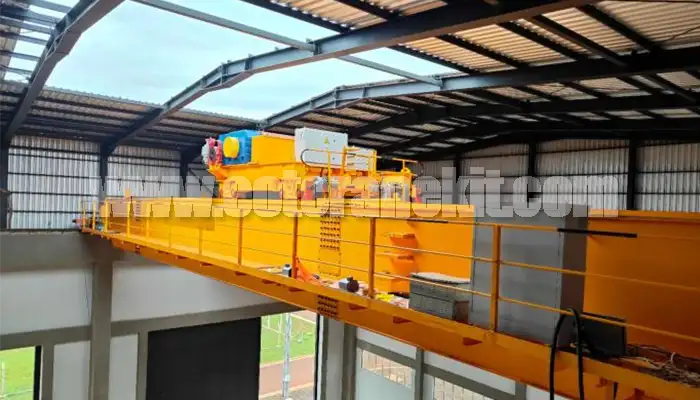
Latest project
150 Ton Overhead Crane Installation Feedback – Paraguay Case
QDX 150 ton overhead crane in action in Paraguay. Installation photos, video, and client feedback show performance, safety, and heavy-lifting efficiency.
Free consultation to Confirm Parameters & Specifications and Get
Latest Crane Price & Crane Rate.
- Types of overhead cranes : _______?
- Optional: Overhead travelling crane, goliath gantry crane,Slewing jib crane, Single girder or double girder crane,small portable crane or kbk crane, etc.
- Capacity of overhead crane: _______?
- Optional: 0.25ton, 0.5 ton, 1 ton, 2 ton, 3ton, 5 ton, 10 ton,15ton, 20ton, 25 ton, 30ton,35ton, up to 550ton, etc.
- Crane span & lifting height : _______?
- Crane travelling length : _____?
- Control of overhead crane:_______?
- Optional: pendant/ remote/cabin control
- Voltage supply of overhead crane:_____?
- Eg,: 380V50/60HZ,3Phase or others,etc.
- Application/usage of crane:_______?
- Eg,: Steel mill, ,injection mold, cement,stone, concrete,granite, general manufacturing, etc.
Just leave a message via the contact form and our hoist and crane engineer will contact you with in 24working hours.
Get In Touch
